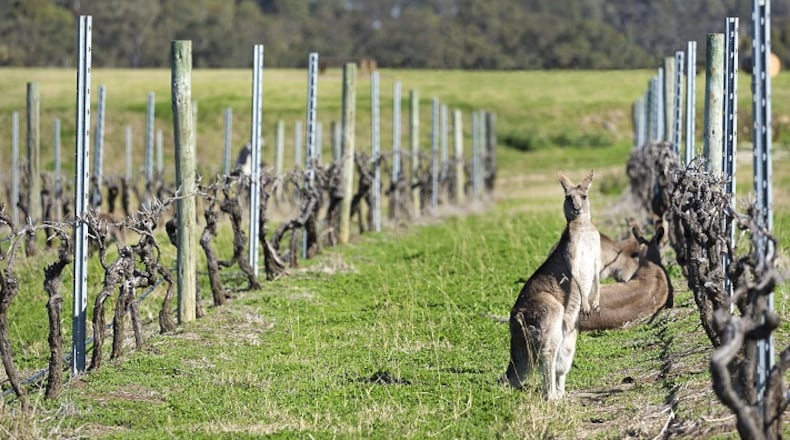Just about all of the words in our native tongue sound deliciously mysterious and foreign when they are spoken by an inhabitant of that faraway land known as Australia, but some of their wine words have a rhythm all their own, no matter who says them: Barossa, Coonawarra, shiraz and stickies.
Recent statistics list Australia as the sixth most productive wine country in the world, though the land Down Under has been at the game awhile. Wine grapes were first planted in the 1700s, but the country started truly pushing its exports in the 1980s and ’90s. Within a handful of years, Australian wine bottles, some of them sporting so-called critter labels (featuring wine mascots such as kangaroos), were everywhere.
For the most part, these wines were recognizable, nonthreatening and cheap. The wine was rarely great, but that was never the focus. Eventually Australia said, “Well, that was easy — now let’s send out better wines,” many of which already existed but had never left home. The push to export those fine wines has been on ever since.
The country is well known as the home of several giant, dependable budget-conscious brands — Hardys, Jacob’s Creek — that line grocery store shelves. So, mass-market appeal is still alive and well, but Australia is also home to thousands of less-visible wineries that make their way here, focusing more on quality than quantity: Henschke, Hewitson, Leeuwin Estate and Tyrrell’s, to name a few. And then you have Penfolds, which is one of the largest wineries the country has ever known, turning out affordable, ubiquitous bottlings, along with one of the finest and most-coveted wines in the world: Penfolds Grange.
Aussies love their wine, landing fairly high in the world rankings when it comes to consumption. What a lot of us know of this place is the cowboy and wildlife-hunter lifestyle of the Outback — the rugged, isolated interior of one of the world’s largest countries by land mass, though not population. It’s rough in the Outback, which is why most of the country’s people — and wine — are concentrated in a few spots along a sort of fertile ribbon that follows the contours of the southern coast.
Most of the wine regions are clustered in the southeast — in the states of New South Wales, Victoria and South Australia — with a straggler group of regions thriving all the way on the opposite coast, in Western Australia. Though that ribbon is unconnected — the place is just too huge — it flows generally through the well-known regions of the Hunter Valley north of Sydney, down to the Yarra Valley near Melbourne, and up again and westward to the city of Adelaide in South Australia, the country’s de facto HQ of wine. The regions Coonawarra, McLaren Vale, Adelaide Hills, Eden Valley, the famed Barossa Valley and Clare Valley cluster around that city. On the opposite coast, Margaret River leads the charge for high-quality wine production.
Australia’s most successful and beloved grape variety is shiraz, the Aussie name for the red French grape known as syrah. Besides the country’s sought-after single varietal expression of shiraz, the grape has also a common blending partner in cabernet sauvignon and is a key player in Oz’s famous GSM blends, short for grenache, shiraz and mourvedre, a version of Rhone’s famous blending formula. Cabernet sauvignon makes for another successful Australian varietal, and on the white side, Australia produces lots of great chardonnay, sauvignon blanc, semillon and riesling (which is mostly dry, citrusy and tangy).
I’m not sure how they feel about Barbies down there, but they love their barbies, the Aussie handle for barbecue grills. Even in a place so large, you could say that there is a sort of national consensus on grilling. Naturally many of the wines they make marry well to the wide variety of open-fire cooking because Australian wines are, for the most part, big and friendly, like the blokes we imagine traversing the treacherous Outback.
The country also turns out bubbles (including sparkling shiraz) and dessert wines, some in the style of port or sherry, known down there as “stickies” for the reasons you can imagine. It’s a delicious moniker, not only because of its uniqueness but also because of the mirth it injects into the diverse wine style — the kind you drink with sweets at the end of a satisfying feast.
Easy-to-read labels, clearly marked with the varietal or wine style in the bottle, make Australian wine shopping a snap. Just keep in mind that there is much more to Australia than the Outback — both in geography and spirit — and much more to Australian wine than the budget-friendly global brands. Check back here in coming weeks for more about Australian wines from specific parts of the country.
About the Author
The Latest
Featured


